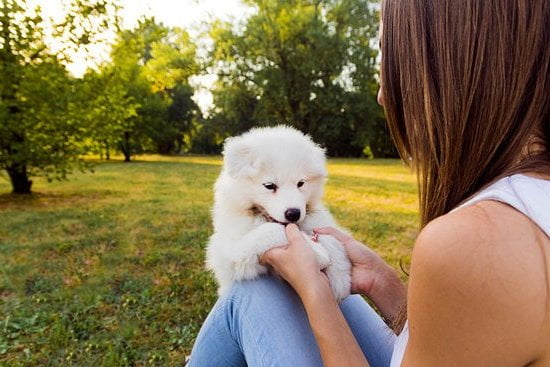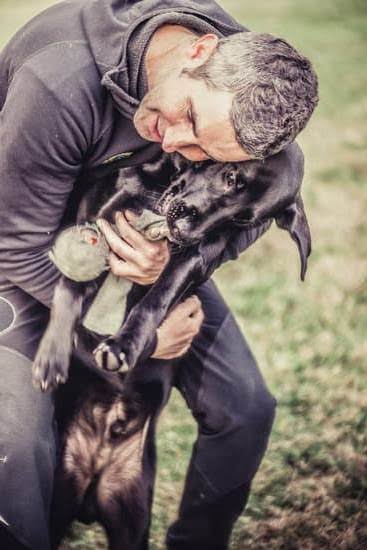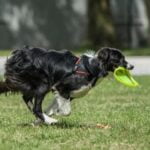Introduction
School therapy dogs are becoming more and more popular among schools due to the mental health benefits they can bring to students. A school therapy dog is a specially-trained dog that is used in educational facilities such as schools, universities, and libraries. The goal of having a therapy dog at school is to provide comfort and security for students in stressful or difficult situations. These special animals accompany teachers and staff members, providing emotional support and giving students an outlet for expressing their feelings.
Training a school therapy dog requires patience and dedication, just like any training program with animals. It involves teaching the animal basic commands like “sit” and “stay” as well as socialization drills to ensure the animal can cope in a busy environment with multiple people around them. Furthermore, it’s important that the animal is able to focus on their handler while still responding positively to all aspects of school life. Establishing mutual trust between the student, therapist, and dog is also essential; this involves exposure exercises so that the dog becomes familiar with people, sounds, sights, ets., in order for them to be comfortable with being handled by unfamiliar people. Finally, it is important that owners remain consistent during the training process to ensure these lessons will stay with them in later years when called upon as a properly certified school therapy dog at their assigned job location.
Knowing the Different Types of School-Based Therapy Dogs
School-based therapy dogs can come in a variety of breeds and sizes, from Rottweilers to Poodles. Each breed has distinct temperaments and strengths to consider when determining which one will best fit into and be most beneficial for the school environment. For example, larger and more active breeds such as Siberian Huskies may be ideal for facilities with large playing fields or lots of outdoor activities. On the other hand, smaller more docile breeds such as Shih Tzus may be better suited for libraries, classrooms and other quiet spaces indoors. It is important to select the type of dog that best meets your school’s individual needs.
After selecting the right breed, there are many different ways to effectively train a school therapy dog. Professional dog trainers can provide consultations on how to handle specific behavior issues or give tips on providing basic obedience training. Additionally, providing positive reinforcement during regular training sessions can help encourage desirable behaviors such as sitting politely when greeting people or responding calmly to loud noises. Positive reinforcement should always be provided immediately following successful completion of an action so that the dog accurately understands what behaviors are expected. Another way to ensure success when training a school therapy dog is by setting up socialization opportunities with a variety of people – including students – inside and outside of the school environment. Finally, it is important to teach the dog emergency cues such as “leave it” or “stay” so that it knows how to respond if something disturbs its normal routine or if too much excitement builds up in a classroom setting. By taking all these considerations into account, schools can successfully train their therapy dogs for helping support their students’ well-being and academic achievement.
The Prerequisites for Training a School Therapy Dog
Before you start to train a school therapy dog, there are some prerequisites you should be aware of. First, the dog must be able to pass a temperament test with a licensed veterinarian. This is important to ensure that the animal is suitable for providing services in an often crowded environment, such as a school. The school therapy dog also needs to pass basic obedience tests, including commands such as sit, stay, come, and heel. Additionally, the animal should have prior experience working with people in various environments; they may have been trained and tested as a service or therapy animal elsewhere, or have completed an assistance-dog training course. Finally, the owner of the school therapist dog should undergo some specialized training in handling and caring for their canine companion before beginning work at a school setting.
Building Positive Affinities Through School Environment Exposure
Training a therapy dog for school is an exciting task! But it should be taken seriously, as it involves ensuring the safety of children and handling public relations. To get started, begin by getting the necessary assurance from local authorities that it is okay to bring a therapy dog into the school setting. This will help you understand any regulatory guidelines or regulations that are in place so that everyone involved remains safe.
Once you’ve received your approval, create a plan for how you’ll introduce and integrate your therapy dog into the school environment. You may want to start off with small group interactions before bringing your canine friend in during larger faculty gatherings and student assemblies. Give students and faculty alike some time to adapt and get familiar with the presence of a therapy animal on campus – don’t rush this process too much as building trust between people and animals takes time.
Organize training sessions specifically suited to children – these exercises should include activities like teaching them behavior commands, rewarding good behavior with treats, and responding to any physical cues of distress (such as panting or barking) in accordance with their age level. This can help foster positive relationships between students, faculty members and the animal – in most cases simply touching or petting your four-legged acquaintance can alleviate feelings of tension or unease in anyone present at the moment.
In addition, it’s important to socialize your therapy dog by exposing him/her to other environments throughout the course of training – this could be walks around campus during recess times or any other situation where he/she could interact with several different human beings on a regular basis; this will also help him/her become accustomed to unfamiliar settings later on when invited to schools outside of his/her normal campus area. Moreover, desensitization tools such as ear plugs or eye masks can be used when introducing noise-heavy environments or bright light sources respectively. Lastly remember that consistency is key: if noise levels rise abruptly be sure to provide verbal reassurances throughout the turbulent moments until calm has been restored without having them feel overwhelmed at any given moment – this will create strong positive affinities over time through consistent reinforcement of favourable behaviors!
Training for Success in Therapy Sessions
When it comes to training a school therapy dog, it is important to ensure that your canine companion possesses the skills and temperament needed for the job. One of the best ways to do this is through positive reinforcement. This involves rewarding your pet with treats, praise, or even playing with a toy whenever he does something you want him to do. This will teach your pup that good behavior is desirable and create an environment in which both of you can work together happily and productively.
It is also important to remember that dogs learn differently from humans, so its best to keep training sessions short and sweet. Each one should last no longer than 10–15 minutes at a time since this will help prevent boredom and ensure success.
It’s also valuable to use different types of rewards such as verbal praise and physical contact. Your pup may enjoy getting scratches behind his ears or chin rubs when he displays improved progress during training sessions. You can also teach him simple commands like “sit” or “stay” which will help him understand how you want him to act around children during therapy visits. Additionally, teaching your pooch how to respond calmly in new situations by introducing him slowly and carefully to unfamiliar people and environments will help prepare him for visits within the school setting. Rewarding desired behaviors with treats can be beneficial in these situations as well since they provide motivation while simultaneously teaching your pup proper manners in public places.
Finally, teaching socialization skills with other animals should also be part of the training process. Working on obedience exercises such as coming when called or staying away from other pets will reinforce appropriate behavior in social settings, making it easier for your pup to remain calm during therapy sessions too!
Dealing With and Alleviating Difficult Behaviors
When it comes to training a school therapy dog, understand that some behaviors may present a challenge. For example, the dog may be easily distracted and have trouble focusing. In order to address this, it is important to provide motivating distractions such as toys or items with different scents. By engaging the dog’s natural curiosity, this can help to reduce the chance of behavioral issues in a school setting. Additionally, it is key to consistently reward the dog for good behavior by offering treats or verbal praise when appropriate. With gentle correction and consistent reinforcement of good behavior, it can also be helpful to establish a set routine for the animal to maintain positive behavior in any settings during its school visits. If more difficult issues arise then it is best for professional advice from an experienced animal behaviorist or trainer who specializes in working with dogs in therapeutic settings. With patient guidance and support, you should be able to successfully train your school therapy dog so they are comfortable and competent while out in public spaces in schools and other areas where your pet will serve people in need.
Strategies for Training a School Therapy Dog
In order to properly train a school therapy dog, there are several key strategies that should be addressed.
First and foremost, the pup must be socialized amid various activities, people and animals to get them used to their environment. Socialization is vital in establishing that strong bond between the dog, handler, and student. It establishes a trusting environment where students feel comfortable interacting with the animal companion.
Additionally, exposure to different surfaces helps ease the transition of being on school grounds. Taking time out of each week to consistently walk around campus and introduce the pup to new experiences can help reduce any stress that may come up during their work day.
Training specific behaviors and activities for schools will be paramount for success at this job. Working with the handlers consistent commands and having clear expectations for expectations in school can help both student and pup reach common goals in their learning journey together. Teaching simple skills such as sit, stay or bring items back can help students interact with the therapy pup more regularly which can help develop trust and comfort.
Lastly but perhaps most importantly is developing an emergency plan for any potential situations that might arise while on school grounds or working with a student . Having these plans implemented ahead of time will save both staff and students from undue fear or anxiety if something chaotic were to occur while they’re around the pup.
Measuring and Determining the Readiness of a Therapy Dog
Before a dog can be qualified for school therapy, it needs to be assessed in terms of its ability to interact with and respond to children. This will determine whether the dog is ready to be part of a school therapy program. There are a few steps that individuals or organizations should take when evaluating a therapy dog’s suitability:
1. Observing the dog’s behavior and body language: Does the dog appear relaxed and friendly around children? Do they seek out human contact and seem responsive to verbal commands or hand signals? Is the dog confident and reactive but not overly persistent? By observing how a potential therapy dog behaves, it’s possible to gauge their environment readiness for a school setting.
2. Assessing basic obedience skills: The ideal therapy dog must have some degree of obedience training under its belt prior to entering into a school program. This means they should understand sit, stay, come, leave it, etc., regardless of who gives the commands. It’s important that they follow instructions reliably and stay focused while in close proximity with students.
3. Examining overall temperament: It is important that the individual or organization evaluates an animal’s overall temperament since this will guide much of their interactions with children at school. Therapy dogs need to remain calm and patient when dealing with potentially loud and disruptive students, as well as responding appropriately when students attempt to express themselves using physical touch or hug them too tightly, for example.
If all these criteria are met by the pet being evaluated, then it may be deemed fit for inclusion in a school therapy program!
Final Thoughts
Training a school therapy dog requires patience and dedication from both the dog and their handler. It is important to recognize and appreciate the amount of work it takes to train a school therapy dog, as the bond that developing between dog and handler will be one of unconditional love. This bond will ultimately result in teaching children how to care for animals, socialize with other people, and gain comfort through companionship. With a lot of practice, hard work, and patience, it is possible for any four-legged friend to become an effective school therapy dog.
Furthermore, it is important to express appreciation for a school therapy dog by showing them love, kindness, and affection during training sessions. A good way of achieving this is with positive reinforcement; rewarding the animal with treats or verbal praise whenever they successfully follow instructions regarding good behavior or have fun completing a task. Additionally, setting up regular playdates with other canine companions can provide your school therapy dog with an outlet where they can practice socializing with other animals – something that is incredibly beneficial for them to learn in order to help other children do the same. Finally, providing regular socialization opportunities for your school therapy canine outside of the classroom environment will allow them invaluable experiences which will benefit both them—and all those who interact with them—immensely!

Welcome to the blog! I am a professional dog trainer and have been working with dogs for many years. In this blog, I will be discussing various topics related to dog training, including tips, tricks, and advice. I hope you find this information helpful and informative. Thanks for reading!





